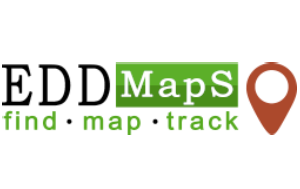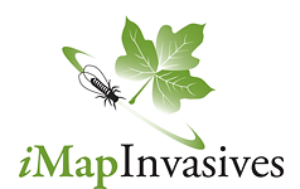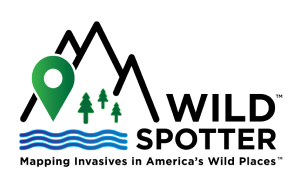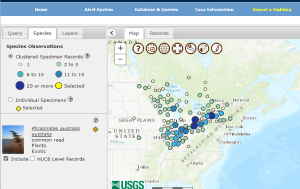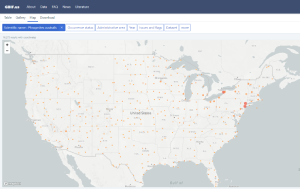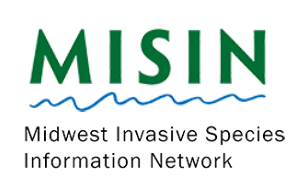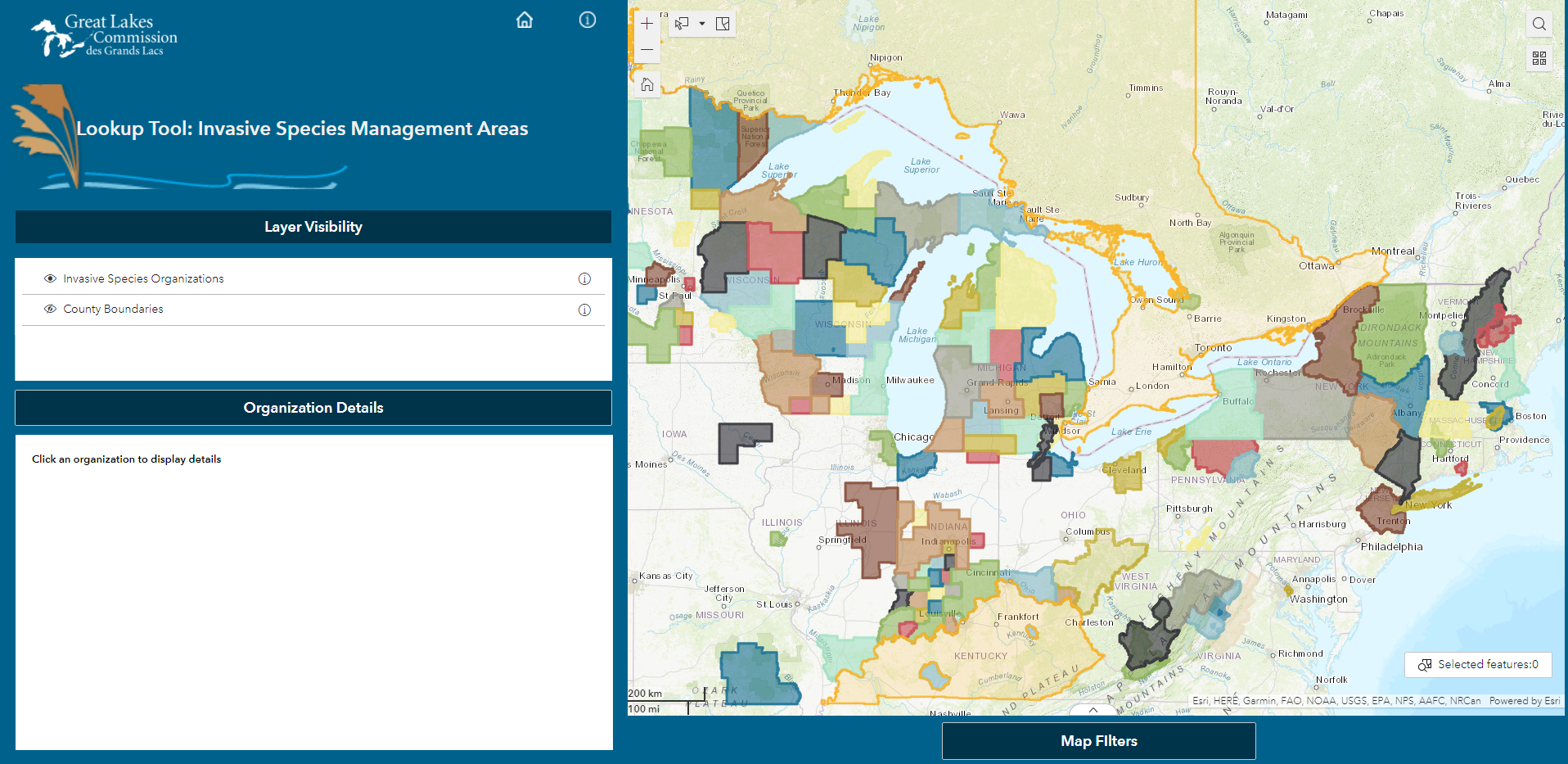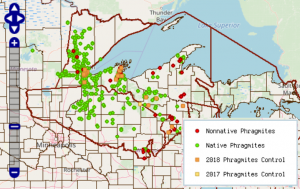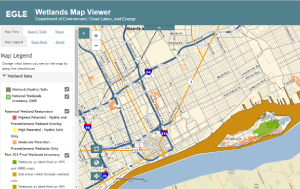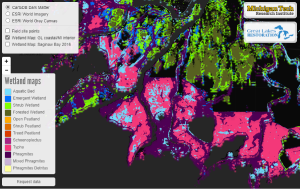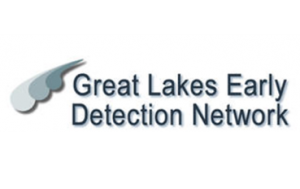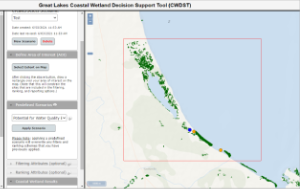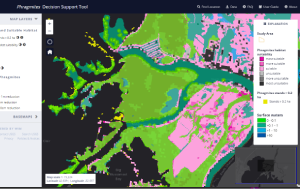Mapping and Monitoring Tools
 Whether you are a manager, researcher, or an interested individual there are a variety of tools you can use to map, monitor, and/or report Phragmites and other invasive species. There are also easily accessible mapping tools for those working in Great Lakes wetlands or who want to find invasive species organizations.
Whether you are a manager, researcher, or an interested individual there are a variety of tools you can use to map, monitor, and/or report Phragmites and other invasive species. There are also easily accessible mapping tools for those working in Great Lakes wetlands or who want to find invasive species organizations.
For each tool below we have identified its target audience and its potential uses but note that these may not apply in all cases—most tools are useable by anyone who is interested! Note that asterisks (*) denote aspects of tools that may only be accessible through payment, group membership, participation in special programs, or limited-service areas.
Are we missing a tool you think we should add? Let us know!
National mapping/reporting tools
Early Detection & Distribution Mapping System (EDDMapS)
EDDMapS is a database of invasive species occurrences as reported by organizations and citizen scientists. There are several sub-categories on this platform, including EDDMapS Ontario.
Who is the target audience?
Anyone in the US/Canada
What can you do?
- Report invasives
- View distribution maps
- Download data
- Sign up for alerts
- Track infestations*
iMapInvasives
A GIS-based data management system used to assist citizen scientists and natural resource professionals working to protect our natural resources from the threat of invasive species. *Only available in participating jurisdictions (Arizona, Maine, New York, Oregon, Pennsylvania, and Saskatchewan).
Who is the target audience?
Anyone in the states listed above
What can you do?
- Report invasives*
- Record area searched*
- View distribution maps*
- Record treatments*
- Download data*
- Generate reports*
Wild Spotter
An invasive species reporting program for plants and animals in select US National Forests and National Grasslands co-led by Wildlife Forever, the University of Georgia, and the USDA Forest Service.
Who is the target audience?
Individuals and private groups in the US
What can you do?
- Report invasives*
- Register as a partner organization*
Nonindigenous Aquatic Species (NAS) Database
NAS is an aquatic invasive species database and alert system maintained by the US Geological Survey. Coverage is limited to the United States.
Who is the target audience?
Anyone in the US
What can you do?
- Report invasives
- View distribution maps
- Sign up for alerts
- Query database
- Produce graphs
- View maps of invasion risk (general and due to floods/storms)
Global Biodiversity Information Facility (GBIF) US data portal
This data portal serves as an access point to U.S. species occurrence data contributed to the Global Biodiversity Information Facility (GBIF). These data are collated from a number of different databases and publications in one convenient spot. (Note: the link will take you to Phragmites australis occurrence data).
Who is the target audience?
Anyone in the US
What can you do?
- View map of invasive species occurrences
- Download data from GBIF
Great Lakes mapping/reporting tools
Midwest Invasive Species Information Network (MISIN)
MISIN is a regional effort to develop and provide early detection and response resources for invasive species.
Who is the target audience?
Anyone in the Midwest
What can you do?
- Report invasives
- View distribution maps
- Request data
- Sign up for alerts
- Identification training
- Track treatments*
Great Lakes Invasive Species Organization Map
The Great Lakes Commission has created an interactive map of Great Lakes invasive species organizations operating at the local and state level.
Who is the target audience?
Individuals and managers in the Great Lakes
What can you do?
- Find the nearest invasive species organization
- Obtain organization contact information
The Great Lakes Indian Fish and Wildlife Commission (GLIFWC) Verified Phragmites Occurrence Map
This dynamic map displays data points for non-native and native Phragmites as well as sites which were managed in 2017 and 2018. Details and metadata are available via downloadable files.
Who is the target audience?
Anyone in the Great Lakes
What can you do?
- Map native and nonnative Phragmites stands and treatment areas
- View a variety of other environmental and treaty resources
Michigan Wetlands Map Viewer
The Michigan Department of Environment, Great Lakes and Energy hosts this interactive map of Michigan wetlands, hydric soils, areas with wetland restoration potential, landcover, streams, floodplains, and other data.
Who is the target audience?
Individuals, managers, and researchers in Michigan
What can you do?
- View Michigan wetlands map
- Measure, create map buffers, draw polygons
- Share map or export data
MTRI Wetland map
Michigan Tech Research Institute has produced a map of wetland vegetation classifications (including Phragmites) across the Great Lakes basin using satellite imagery from 2007-2011 (and 2016 for Saginaw Bay). Methods for map production can be found here.
Who is the target audience?
Anyone in the Great Lakes
What can you do?
- View wetlands map
- Request map data
Great Lakes Early Detection Network (GLEDN)
GLEDN is an invasive species network working to rapidly respond to new invasive species sightings in the Great Lakes states. GLEDN is connected to a variety of partner databases.
Who is the target audience?
Anyone in the Great Lakes
What can you do?
- Report invasives
- View distribution maps
Great Lakes Decision Support Tools
Great Lakes Coastal Wetland Decision Support Tool (CWDST)
The CWDST is a web-based data viewer and prioritization tool that generates maps of monitored Great Lakes coastal wetlands using a variety of data relevant to conservation and management.
Who is the target audience?
Managers and researchers in the Great Lakes
What can you do?
- Map many geographic attributes associated with coastal wetlands (including Phragmites stands)
- Use a decision support tool to filter or rank wetlands by different variables
- View wetland monitoring data through an alternate mapping tool
Phragmites Decision Support Tool
The US Geological Survey’s Phragmites Decision Support Tool is intended to provide resource managers with information to strategically develop effective Phragmites control and invasion prevention programs in the Great Lakes coastal zone (10 km inland from the shoreline).
Who is the target audience?
Managers in the Great Lakes
What can you do?
- Map coastal Phragmites stands, habitat suitability indices, and potential invasion pathways
- Download map data

